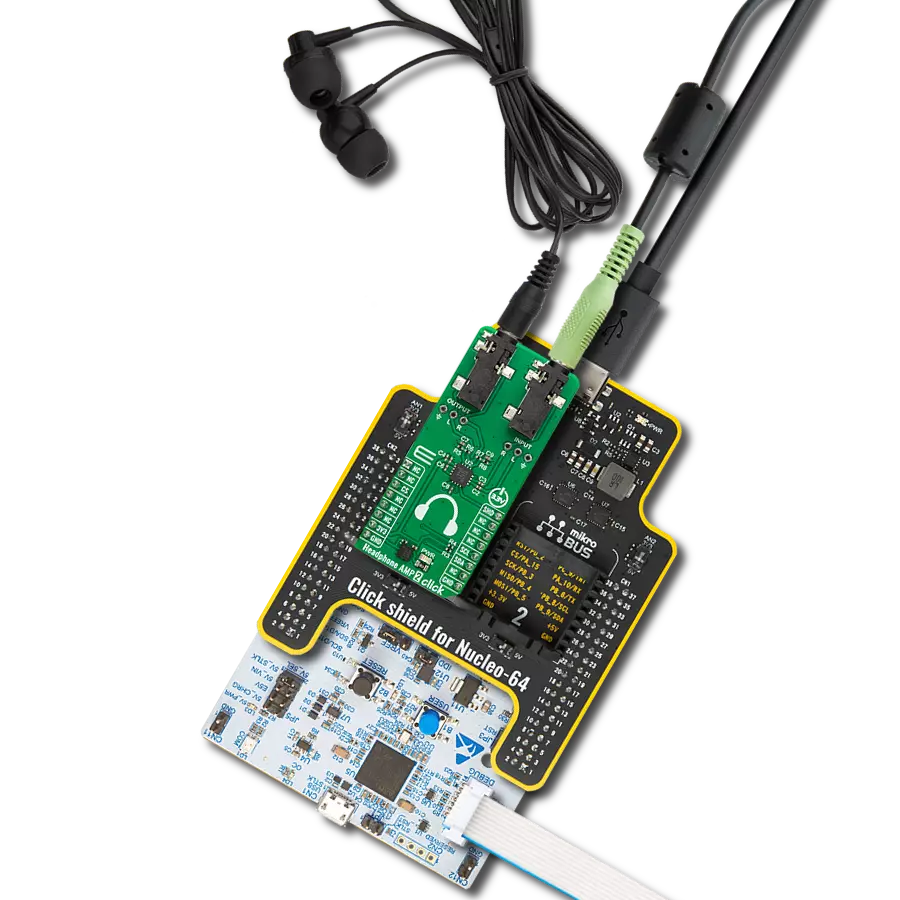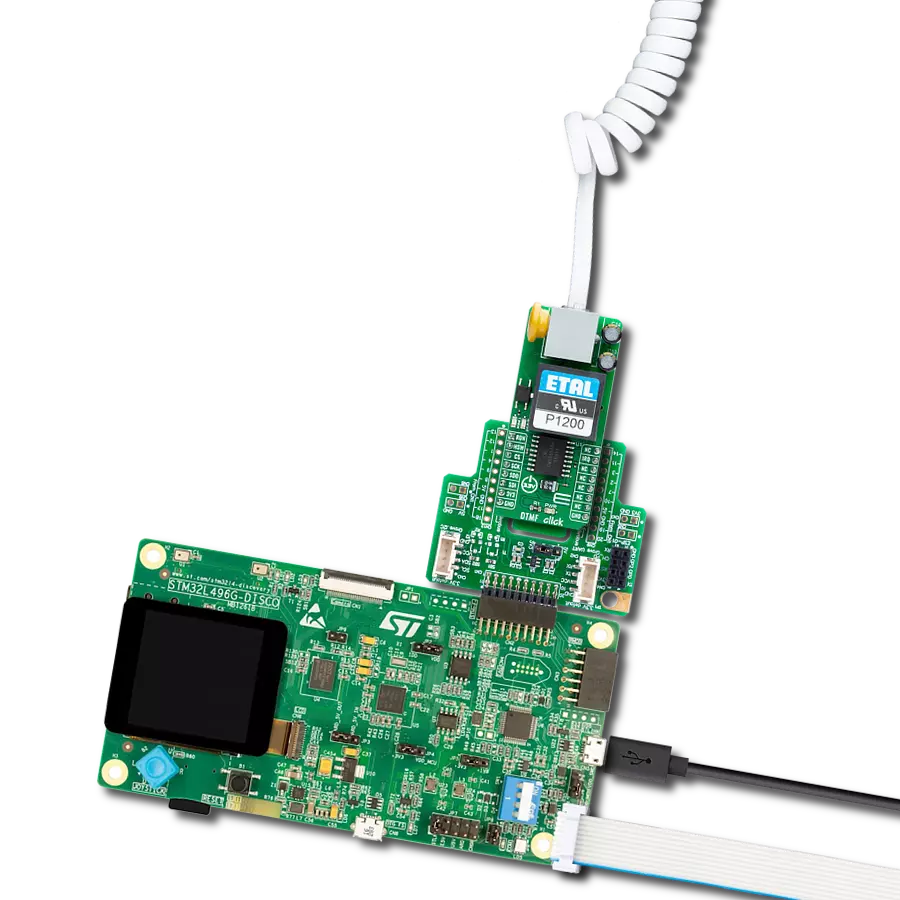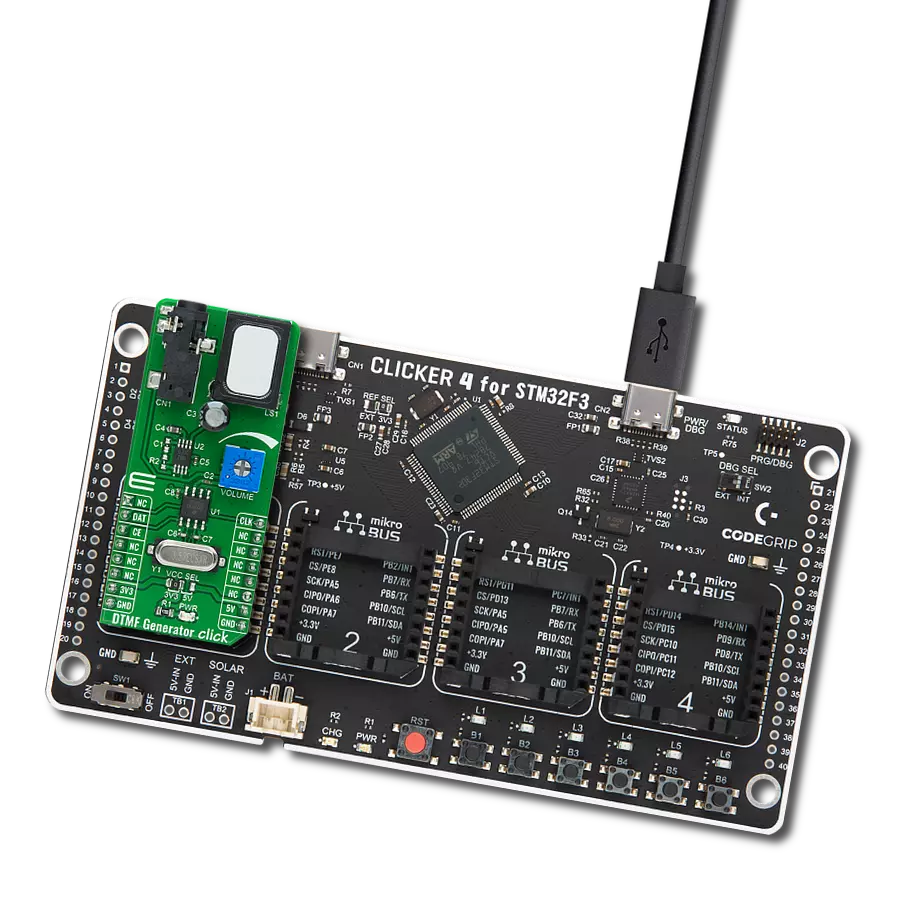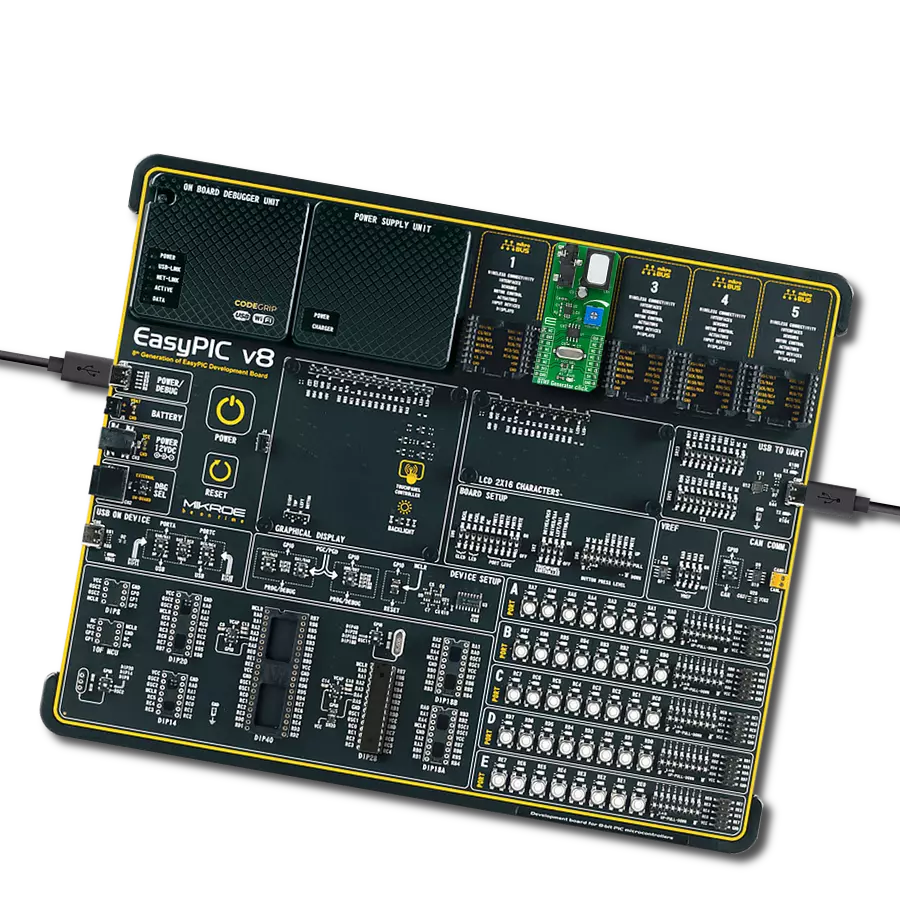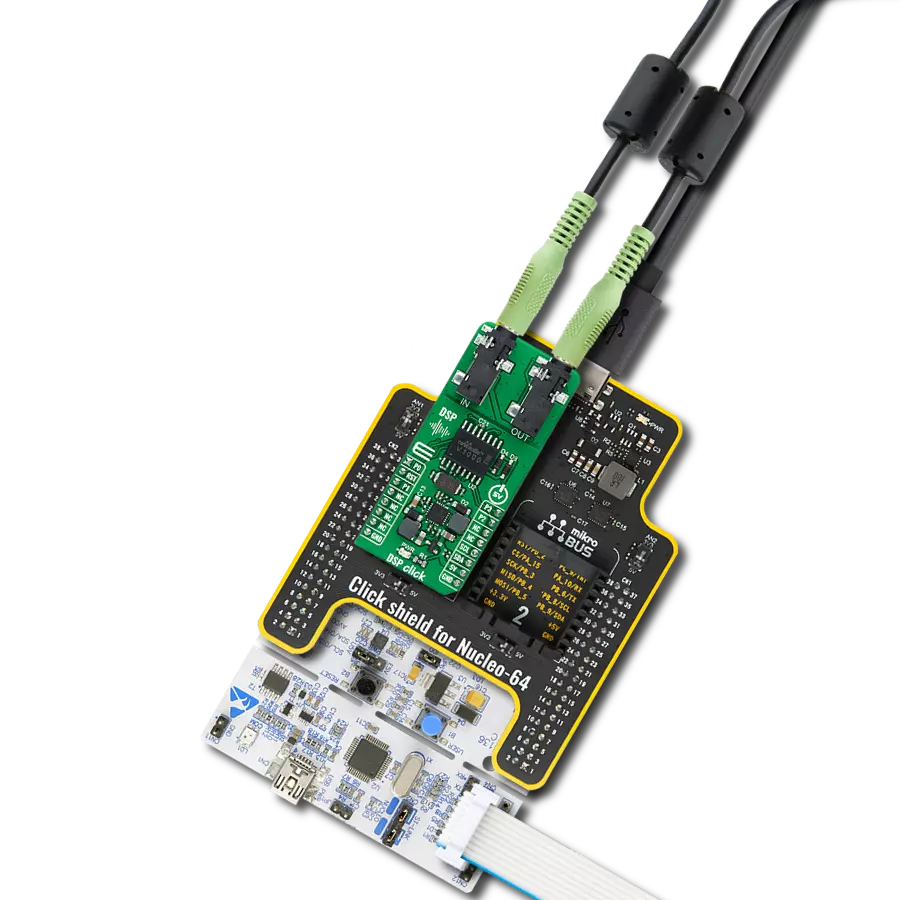Enable secure, low-power modem communication for EPOS terminals and remote systems ideal for reliable data transfer in industrial control and security applications
A
A
Hardware Overview
How does it work?
EPOS Module Click is based on the CMX869B, a multi-standard v.32 bis modem from CML Micro, which supports multiple protocols while offering low power consumption. This low-power modem solution is designed for applications involving EPOS (Electronic Point of Sale) terminals and telephone-based systems. The CMX869B supports standards such as ITU V.32 bis, V.22 bis, V.22, V.21, and Bell 202 and 103, making it adaptable for numerous communication scenarios. It operates at data rates of up to 14.400bps and features automatic fallback to 4.800bps, with capabilities like retrain rate re-negotiation and automatic detection of V.22 and V.22 bis modems. This Click board™ is ideal for use in EPOS terminals, telephone telemetry systems, remote utility meter reading, security systems, industrial control, and other applications. In addition to its robust modem
functions, the CMX869B includes a high-quality DTMF (Dual-Tone Multi-Frequency) encoder and decoder, making it suitable for managing call signaling and detection in telephone systems. The modem can also transmit and detect user-programmed single and dual-tone signals, as well as handle modem calling and answering tones, ensuring compatibility with various proprietary communication protocols beyond standard modem operations. The Click board™ also offers a fully isolated EPOS/telephone-based connection, thanks to its built-in P1200 transformer, which ensures smooth communication while providing complete electrical isolation. Data and control exchanges between the CMX869B and the host MCU are made through a C-BUS interface, compatible with a standard 4-wire SPI interface of the mikroBUS™ socket. The board also uses the mikroBUS™
socket's IRQ pin for interrupt requests related to call states like busy, dialing, and connected statuses, a red RING LED to indicate ringing signals, and a blue HOOK LED that serves as a hookswitch indicator to manage the line interface's connectivity status (0-OFF, 1-ON). An additional feature of the CMX869B is the Powersave mode, which conserves energy by deactivating all circuits except the essential C-BUS (SPI) interface. This Click board™ can be operated only with a 3.3V logic voltage level. The board must perform appropriate logic voltage level conversion before using MCUs with different logic levels. Also, it comes equipped with a library containing functions and an example code that can be used as a reference for further development.
Features overview
Development board
Nucleo 32 with STM32F031K6 MCU board provides an affordable and flexible platform for experimenting with STM32 microcontrollers in 32-pin packages. Featuring Arduino™ Nano connectivity, it allows easy expansion with specialized shields, while being mbed-enabled for seamless integration with online resources. The
board includes an on-board ST-LINK/V2-1 debugger/programmer, supporting USB reenumeration with three interfaces: Virtual Com port, mass storage, and debug port. It offers a flexible power supply through either USB VBUS or an external source. Additionally, it includes three LEDs (LD1 for USB communication, LD2 for power,
and LD3 as a user LED) and a reset push button. The STM32 Nucleo-32 board is supported by various Integrated Development Environments (IDEs) such as IAR™, Keil®, and GCC-based IDEs like AC6 SW4STM32, making it a versatile tool for developers.
Microcontroller Overview
MCU Card / MCU

Architecture
ARM Cortex-M0
MCU Memory (KB)
32
Silicon Vendor
STMicroelectronics
Pin count
32
RAM (Bytes)
4096
You complete me!
Accessories
Click Shield for Nucleo-32 is the perfect way to expand your development board's functionalities with STM32 Nucleo-32 pinout. The Click Shield for Nucleo-32 provides two mikroBUS™ sockets to add any functionality from our ever-growing range of Click boards™. We are fully stocked with everything, from sensors and WiFi transceivers to motor control and audio amplifiers. The Click Shield for Nucleo-32 is compatible with the STM32 Nucleo-32 board, providing an affordable and flexible way for users to try out new ideas and quickly create prototypes with any STM32 microcontrollers, choosing from the various combinations of performance, power consumption, and features. The STM32 Nucleo-32 boards do not require any separate probe as they integrate the ST-LINK/V2-1 debugger/programmer and come with the STM32 comprehensive software HAL library and various packaged software examples. This development platform provides users with an effortless and common way to combine the STM32 Nucleo-32 footprint compatible board with their favorite Click boards™ in their upcoming projects.
Used MCU Pins
mikroBUS™ mapper
Take a closer look
Click board™ Schematic

Step by step
Project assembly
Track your results in real time
Application Output
1. Application Output - In Debug mode, the 'Application Output' window enables real-time data monitoring, offering direct insight into execution results. Ensure proper data display by configuring the environment correctly using the provided tutorial.

2. UART Terminal - Use the UART Terminal to monitor data transmission via a USB to UART converter, allowing direct communication between the Click board™ and your development system. Configure the baud rate and other serial settings according to your project's requirements to ensure proper functionality. For step-by-step setup instructions, refer to the provided tutorial.

3. Plot Output - The Plot feature offers a powerful way to visualize real-time sensor data, enabling trend analysis, debugging, and comparison of multiple data points. To set it up correctly, follow the provided tutorial, which includes a step-by-step example of using the Plot feature to display Click board™ readings. To use the Plot feature in your code, use the function: plot(*insert_graph_name*, variable_name);. This is a general format, and it is up to the user to replace 'insert_graph_name' with the actual graph name and 'variable_name' with the parameter to be displayed.

Software Support
Library Description
This library contains API for EPOS Module Click driver.
Key functions:
eposmodule_handshake_init- This function performs a handshake init which resets the device settings to default.eposmodule_dial- This function dials the selected number by alternating between DTMF and No-tone.eposmodule_send_message- This function sends an array of bytes via V.23 FSK 1200bps modem in start-stop 8.1 mode.
Open Source
Code example
The complete application code and a ready-to-use project are available through the NECTO Studio Package Manager for direct installation in the NECTO Studio. The application code can also be found on the MIKROE GitHub account.
/*!
* @file main.c
* @brief EPOS Module Click example
*
* # Description
* This example demonstrates the use of EPOS Module Click board by showing
* the communication between the two Click boards connected to PBX system.
*
* The demo application is composed of two sections :
*
* ## Application Init
* Initializes the driver and logger, and displays the selected application mode.
*
* ## Application Task
* Dialing application mode:
* - Resets the device settings and dials the selected number. If a call is answered
* it starts sending desired messages every couple of seconds with constantly checking
* if a call is still in progress or it's terminated from the other side.
* Answering application mode:
* - Resets the device settings and waits for an incoming call indication, answers the call,
* and waits for a desired number of messages. The call is terminated after all messages
* are received successfully.
*
* @note
* We have used a Yeastar S20 VoIP PBX system for the test, where the Click boards are
* connected to ports 1 and 2 configured as FXS extension with numbers 1000 and 1001 (dialer).
*
* @author Stefan Filipovic
*
*/
#include "board.h"
#include "log.h"
#include "eposmodule.h"
// Demo aplication selection macros
#define APP_DIALING 0
#define APP_ANSWERING 1
#define DEMO_APP APP_DIALING
// Dialing application settings - a dial number and text to send (must end with CRLF - \r\n)
#define DIAL_NUMBER "1000"
#define TEXT_TO_SEND "MIKROE - EPOS Module Click\r\n"
// Answering application settings - a number of successfully received messages before call termination
#define NUM_MESSAGES 5u
static eposmodule_t eposmodule;
static log_t logger;
void application_init ( void )
{
log_cfg_t log_cfg; /**< Logger config object. */
eposmodule_cfg_t eposmodule_cfg; /**< Click config object. */
/**
* Logger initialization.
* Default baud rate: 115200
* Default log level: LOG_LEVEL_DEBUG
* @note If USB_UART_RX and USB_UART_TX
* are defined as HAL_PIN_NC, you will
* need to define them manually for log to work.
* See @b LOG_MAP_USB_UART macro definition for detailed explanation.
*/
LOG_MAP_USB_UART( log_cfg );
log_init( &logger, &log_cfg );
log_info( &logger, " Application Init " );
// Click initialization.
eposmodule_cfg_setup( &eposmodule_cfg );
EPOSMODULE_MAP_MIKROBUS( eposmodule_cfg, MIKROBUS_1 );
if ( SPI_MASTER_ERROR == eposmodule_init( &eposmodule, &eposmodule_cfg ) )
{
log_error( &logger, " Communication init." );
for ( ; ; );
}
#if ( DEMO_APP == APP_DIALING )
log_printf( &logger, " Application Mode: Dialing\r\n" );
#elif ( DEMO_APP == APP_ANSWERING )
log_printf( &logger, " Application Mode: Answering\r\n" );
#else
#error "Selected application mode is not supported!"
#endif
log_info( &logger, " Application Task " );
}
void application_task ( void )
{
uint8_t state = EPOSMODULE_STATE_IDLE;
uint32_t time_cnt = 0;
uint8_t msg_cnt = 0;
eposmodule_handshake_init ( &eposmodule );
#if ( DEMO_APP == APP_DIALING )
log_printf( &logger, "\r\n Hook OFF\r\n" );
eposmodule_hook_off ( &eposmodule );
Delay_ms ( 1000 );
Delay_ms ( 1000 );
Delay_ms ( 1000 );
Delay_ms ( 1000 );
log_printf( &logger, " Dial: %s\r\n", ( char * ) DIAL_NUMBER );
eposmodule_dial ( &eposmodule, DIAL_NUMBER );
eposmodule.rx_mode &= EPOSMODULE_RX_LEVEL_MASK; // No change in rx level setting
eposmodule.rx_mode |= ( EPOSMODULE_RX_MODE_DTMF_TONES | EPOSMODULE_RX_TONE_DETECT_CALL_PROG );
eposmodule_set_receive_mode ( &eposmodule, eposmodule.rx_mode );
for ( ; ; )
{
Delay_ms ( 1 );
if ( !eposmodule_get_irq_pin ( &eposmodule ) )
{
time_cnt = 0;
state = EPOSMODULE_STATE_IRQ_SET;
}
if ( ( EPOSMODULE_STATE_IRQ_SET == state ) && !eposmodule_call_progress ( &eposmodule ) )
{
if ( time_cnt < EPOSMODULE_TIMING_BUSY )
{
log_printf( &logger, " Busy\r\n" );
break;
}
else if ( time_cnt < EPOSMODULE_TIMING_DISCONNECTED )
{
log_printf( &logger, " Disconnected\r\n" );
break;
}
else if ( time_cnt < EPOSMODULE_TIMING_RINGING )
{
log_printf( &logger, " Ringing\r\n" );
state = EPOSMODULE_STATE_RINGING;
}
}
if ( ( EPOSMODULE_STATE_RINGING == state ) && ( time_cnt > EPOSMODULE_TIMING_CALL_PROGRESS ) )
{
log_printf( &logger, " Call in progress\r\n" );
state = EPOSMODULE_STATE_CALL_IN_PROGRESS;
time_cnt = 0;
}
if ( ( EPOSMODULE_STATE_CALL_IN_PROGRESS == state ) && !( time_cnt % EPOSMODULE_TIMING_SEND_MESSAGE ) )
{
log_printf( &logger, " Send message %u\r\n", ( uint16_t ) msg_cnt++ );
eposmodule_send_message ( &eposmodule, TEXT_TO_SEND, strlen ( TEXT_TO_SEND ) );
}
if ( time_cnt++ > EPOSMODULE_TIMEOUT_CALL_PROGRESS )
{
log_printf( &logger, " Timeout\r\n" );
break;
}
}
log_printf( &logger, " Hook ON\r\n" );
eposmodule_hook_on ( &eposmodule );
Delay_ms ( 1000 );
Delay_ms ( 1000 );
Delay_ms ( 1000 );
Delay_ms ( 1000 );
#elif ( DEMO_APP == APP_ANSWERING )
uint8_t rx_data = 0;
uint8_t msg_end_buff[ 2 ] = { 0 };
log_printf( &logger, "\r\n Waiting for a call...\r\n" );
while ( !eposmodule_ring_detect ( &eposmodule ) );
Delay_ms ( 1000 );
log_printf( &logger, " Hook OFF\r\n" );
eposmodule_hook_off ( &eposmodule );
Delay_ms ( 1000 );
log_printf( &logger, " Waiting for %u messages...\r\n", ( uint16_t ) NUM_MESSAGES );
eposmodule.rx_mode &= EPOSMODULE_RX_LEVEL_MASK; // No change in rx level setting
eposmodule.rx_mode |= ( EPOSMODULE_RX_MODE_V23_FSK_1200 | EPOSMODULE_RX_DATA_FORMAT_SS_NO_OVS |
EPOSMODULE_RX_DATA_PARITY_8_NO_PAR );
eposmodule_set_receive_mode ( &eposmodule, eposmodule.rx_mode );
for ( ; ; )
{
Delay_ms ( 1 );
if ( !eposmodule_get_irq_pin ( &eposmodule ) )
{
if ( EPOSMODULE_STATE_IDLE != state )
{
log_printf( &logger, "\r\n Disconnected\r\n" );
break;
}
log_printf( &logger, " Message %u: ", ( uint16_t ) msg_cnt );
state = EPOSMODULE_STATE_IRQ_SET;
time_cnt = 0;
}
if ( ( EPOSMODULE_STATE_IRQ_SET == state ) && !( time_cnt % EPOSMODULE_TIMING_RX_READY ) )
{
if ( eposmodule_unscram_1s_det ( &eposmodule ) && eposmodule_rx_ready ( &eposmodule ) )
{
eposmodule_receive_data ( &eposmodule, &rx_data );
if ( ( ( ' ' <= rx_data ) && ( '~' >= rx_data ) ) ||
( '\r' == rx_data ) || ( '\n' == rx_data ) )
{
log_printf( &logger, "%c", ( char ) rx_data );
}
if ( '\r' == rx_data )
{
msg_end_buff[ 0 ] = rx_data;
}
else if ( '\n' == rx_data )
{
msg_end_buff[ 1 ] = rx_data;
}
else
{
msg_end_buff[ 0 ] = 0;
msg_end_buff[ 1 ] = 0;
}
}
if ( ( '\r' == msg_end_buff[ 0 ] ) && ( '\n' == msg_end_buff[ 1 ] ) )
{
msg_end_buff[ 0 ] = 0;
msg_end_buff[ 1 ] = 0;
state = EPOSMODULE_STATE_IDLE;
if ( NUM_MESSAGES == ++msg_cnt )
{
Delay_ms ( 100 );
log_printf( &logger, " Terminate call\r\n" );
Delay_ms ( 100 );
break;
}
}
}
if ( time_cnt++ > EPOSMODULE_TIMING_WAIT_FOR_MESSAGE )
{
log_printf( &logger, "\r\n Timeout\r\n" );
break;
}
}
log_printf( &logger, " Hook ON\r\n" );
eposmodule_hook_on ( &eposmodule );
Delay_ms ( 1000 );
Delay_ms ( 1000 );
Delay_ms ( 1000 );
Delay_ms ( 1000 );
#endif
}
int main ( void )
{
/* Do not remove this line or clock might not be set correctly. */
#ifdef PREINIT_SUPPORTED
preinit();
#endif
application_init( );
for ( ; ; )
{
application_task( );
}
return 0;
}
// ------------------------------------------------------------------------ END
Additional Support
Resources
Category:Signal Processing




















